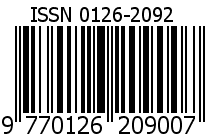THE POTENTIAL GRAM-NEGATIVE ENDOPHYTIC BACTERIA FROM PEGAGAN (Centella asiatica) WITH QUORUM-QUENCHING ACTIVITY
Abstract
Background: Quorum-sensing is communication between bacterial involved in virulence. Bacterial virulence can be inhibited by quorum-quenching mechanism. Endophytic bacteria of pegagan leaf may produce secondary metabolit similar to bioactive compounds in the leaf wich can act in quorum-quenching; Aims: The study aimed to determine quorum-quenching ability in gram-negative bacteria from pegagan leaf; Methods: Gram-negative endophytic bacteria from pegagan were isolated, purified and subcultured by streak plate method on Nutrient Agar. Quorum-quenching activity was evaluated by measuring the purple color inhibition zone of C. violaceum. Five Bacteria with the largest inhibition zones were characterized based on the characteristics of colony morphology, cell morphology and biochemical activities; Results: A total of 15 pure isolates of Gram-negative endophytic bacteria were obtained from 46 pure isolates of endophytic bacteria from Centella asiatica leaves. All isolates of Gram-negative endophytic bacteria showed quorum-quenching activity with inhibitory zones ranged from 9.0 to 13.0 mm. Five isolates that showed the largest quorum-quenching activity were included in genus Flavimonas, Flavobacterium and Acinetobacter; Conclusions: Gram-negative endophytic bacteria from pegagan leaf (Centella asiatica) potential to have quorum-quenching activity against Chromobacterium violaceum.
Keywords
Full Text:
PDFReferences
Kalia VC. Quorum sensing vs quorum quenching : a battle with no end in sight. Illustration ed. Jamuna bai aswathanarayan vrr, editor. Delhi, india: springer; 2015. 73 p.
Nagy MM. Quorum sensing inhibitory activities of various folk-medicinal plants and the thyme-tetracycline effect; 2010.
Basavaraju M, Sisnity VS, Palaparthy R, Addanki PK. Quorum quenching: signal jamming in dental plaque biofilms. Journal of dental sciences; 2016.
Nazzaro F, Fratianni F, Coppola R. Quorum sensing and phytochemicals. International journal of molecular sciences; 2013:12608-18.
Rasmussen TB, Givskov M. Quorum sensing inhibitors: a bargain of effects. Microbiology; 2006:895-904.
Soeharsono. Zoonosis penyakit menular dari hewan ke manusia. 5th ed. Yogyakarta: penerbit kanisius; 2009.
Stauff DL, Bassler BL. Quorum sensing in chromobacterium violaceum: dna recognition and gene regulation by the cvir receptor. Journal of bacteriology; 2011;193:3871-8.
Mclean RJC, Peirson LS, Fuqua C. A simple screening protocol for the identification of quorum signal antagonists. Journal of microbiological methods; 2004:352-60.
Vasavi HS, Arun AB, Rekha PD. Anti-quorum sensing activity of flavonoidrich fraction from centella asiatica l. Against pseudomonas aeruginosa pao1. Journal of microbiology, immunology and infection; 2014:8-15.
Strobel S, Daisy B. Bioprospecting for microbial endophytes and their natural products. Microbiology and molecular biology reviews; 2003;67:491-502.
Kumar A, Singh R, Yadav A, Giri DD, Singh PK, Pandey KD. Isolation and characterization of bacterial endophytes of curcuma longa l. Springer; 2016;6:60.
Coombs JT, Franco CMM. Isolation and identification of actinobacteria from surface sterilized wheat roots. Appl environ microbial; 2003;69:5603-8.
Anjum N, Chandra R. Endophytic bacteria optimizaton of isolation procedure from various medicinal plants and their preliminary characterization. Asian j of pharm and clin res; 2015;8:233-8.
Fitriyah D. Karakterisasi bakteri penghasil asil homoseril lakton laktonase dan asilase yang diisolasi dari lahan pertanian. Bogor: ipb; 2015.
Mc DG, Russel AD. Antiseptic and disinfectants: activity, action and resistence: Clinical Microbiology Review; 1999.
Agustina A. Biologi dan kimia fungi endofit. Cibinong: Penebit ITB; 2009.
Tilakchand, Mahima. A comparative evaluation of the effect of 1% sodium hypochlorite and 2% chlorhexidine on the surface texture of gutta-percha and resilon cones using atomic force microscope: J Conserv Dent; 2014.
Munif A, Hipi A. Potensi bakteri endofit dan rhizosfer dalam meningkatkan pertumbuhan jagung. Bogor: Seminar National Serelia, IPB; 2011.
Dwidjoseputro. Dasar-dasar mikrobiologi. Jakarta: Penerbit Djambatan; 1998.
Fitriyah, Dina, Christine J, Saryono. Skrining aktivitas antimikroba dan uji fitokimia dari kapang endofitik tanaman dahlia (Dahlia variabilis). J. Ind: Che. Acta; 2009.
Ardani YB. Uji aktivitas antibakteri dan anti-quorum sensing fraksi dari ekstrak etanol daun salam (Eugenia polyantha Wight). Surabaya: Fakultas Farmasi, Universitas Katolik Widya Mandala; 2013.
Harshad LD, Kweon JH. Quorum quenching mediated approaches for control of membrane biofouling. International journal of biological sciences; 2014;10:550-65.
Tan CH, Koh KS, Xie C, Zhang J, Tan XH, Lee GP, Zhou Y, Ng WJ, Rice SA, Kjelleberg S. Community quorum sensing signalling and quenching: microbial granular biofilm assembly. Nanyang Technological University: Macmillan Publishers Limited; 2015.
Romero M, Herrera RA, Magarinos B, C´amara M, Otero A. Acylhomoserine lactone productionand degradation by thesh pathogen Tenacibaculum maritimum, a member of the Cytophaga-Flavobacterium-Bacteroides (CFB) group. Federation of European Microbiological Societies: Blackwell Publishing Ltd; 2010.
Chan GK, Atkinson S, Mathee K, Sam CK, Chhabra SR, Camara M, Koh CL, Williams P. Characterization of N-acylhomoserine lactonedegrading bacteria associated with the Zingiber officinale (ginger) rhizosphere: Co-existence of quorum quenching and quorum sensing in Acinetobacter and Burkholderia. Malaysia: BMC Microbiology; 2011
Fitriani A, Ayuningtyas DP, Kusnadi. Inhibition of quorum sensing in chromobacterium violaceum cv026 by violacein produced by pseudomonas aeruginosa. Indonesia: Horizon Publisher; 2016.
OH HS, Lee CH. Origin and evolution of quorum quenching technology for biofouling control in MBRs for wastewater treatment. Singapore: Elsevier; 2018





















